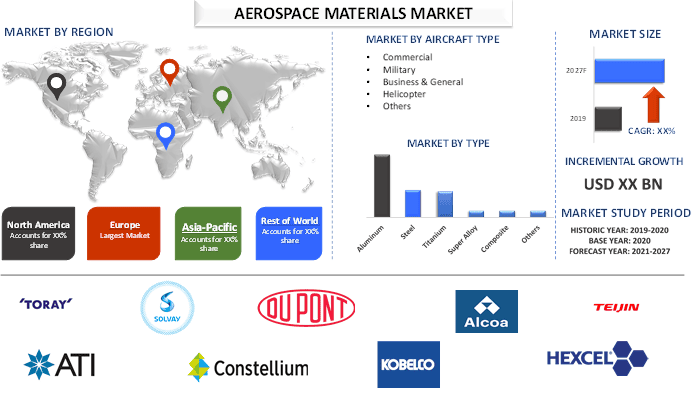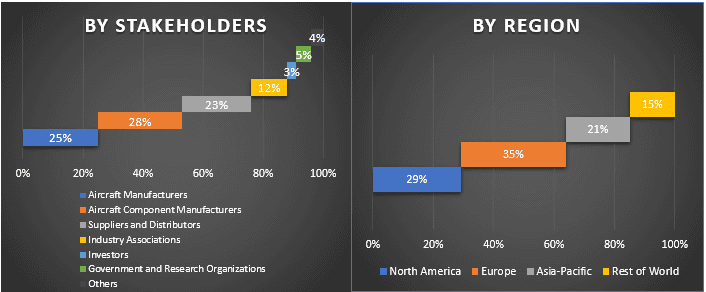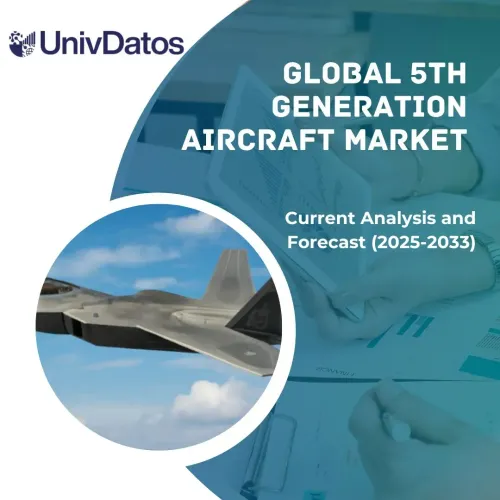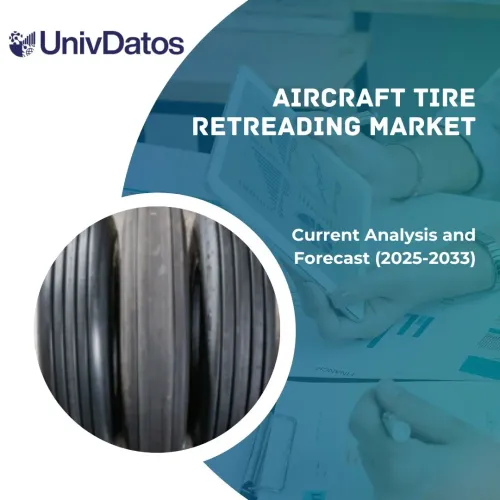- Home
- About Us
- Industry
- Services
- Reading
- Contact Us
Aerospace Materials Market: Current Analysis and Forecast (2021-2027)
Emphasis on Material Type (Aluminum, Steel, Titanium, Super Alloy, Composite, and Others); Aircraft Type (Commercial, Military, Business & General, Helicopter, and Others); Region/Country

The global Aerospace Materials market was stood around $34 billion in 2020 and is expected to demonstrate the growth of above 7% during the forecast period (2021-2027). The global market of aerospace materials is increasing on account of growing demand of aircraft in order to meet the growing airline travel. In developing countries like India, emergence of low-cost airlines increases the airline travels among middle-income population. This in turn, increases the low-cost aircraft demand, as a result, demand of aerospace materials like aluminum, steel, titanium, and composites among others is increasing. For instance, the production of crude steel rose to 1,878 million tons in 2020 from 1,435 million tons in 2010. In addition, production of primary aluminum stood at 65,325 thousand tons in 2020 compared to 42,353 thousand tons in 2010. Further, shifting aircraft manufacturer focus on reducing the aircraft weight without compromising on performance is increasing new materials demand like composites and super alloys. For instance, Aircrafts like Boeing 787 and Airbus A350 have been largely made of the material mix of carbon fibers and polymer resins.
COVID-19 affected the aerospace materials market negatively. Ban on traveling, resulting in the less demand of commercial and general aircraft, as a result production activity of new aircraft was halted. This in turn affected the whole ecosystem of aerospace industry including supplier and distributors of aerospace materials and manufacturer of aircraft components.
Insights Presented in the Report
“Amongst material type, aluminum category held prominent share in the market in 2020.”
Based on material type, the market is categorized into aluminum, steel, titanium, super alloy, composite, and others. Among these, aluminum held the significant share in the aerospace material market in 2020. A large number of aircraft component such as fuselage and wings are manufacture using aluminum alloy. Further, increasing aluminum demand from large number of industries, increasing aerospace industry focus on recycle aluminum. In addition, shifting trend towards low-weight aircraft, is likely to increase aluminum alloys demand like aluminum-lithium, which can reduce the weight and improve aircraft performance.
“Amongst aircraft type, commercial aircraft dominated the market in 2020.”
Based on aircraft type, the market is categorized into commercial, military, business & general, helicopter, and others. Among these, commercial aircraft held the largest market share owing to high demand of aircraft and large number of materials consumptions during the manufacturing operations. Further, increasing penetration of airline travel in developing economies, increasing the commercial aircraft demand in order to meet the growing demand.
“Europe held the considerable market share owing to well-established aerospace industry in the region”
For a better understanding of the market adoption of Aerospace Material, the market is analyzed based on its worldwide presence in the countries such as North America (United States, Canada, Rest of North America), Europe (Germany, UK, France, Spain, and Rest of Europe), Asia-Pacific (China, Japan, India, Australia, and Rest of APAC), and Rest of World. Europe held the prominent share in the market in 2020 owing to large manufacturing of aircraft in the region. Germany, France, and U.K. are among the largest exporter of aerospace products in the world. In 2020, Europe sold the highest dollar value worth of aerospace products onto international markets at 43% of the worldwide total. Some of the major players operating in the market include Toray Industries Inc., Solvay S.A., DuPont de Nemours Inc., Alcoa Corporation, Teijin Limited, Allegheny Technologies Incorporated, Constellium SE, Kobe Steel Ltd., AMG N.V., and Hexcel Corporation.
Reasons to buy this report:
- The study includes market sizing and forecasting analysis validated by authenticated key industry experts
- The report presents a quick review of overall industry performance at one glance
- The report covers in-depth analysis of prominent industry peers with a primary focus on key business financials, product portfolio, expansion strategies, and recent developments
- Detailed examination of drivers, restraints, key trends, and opportunities prevailing in the industry
- The study comprehensively covers the market across different segments
- Deep dive country level analysis of the industry
Customization Options:
The global Aerospace Materials Market can further be customized as per the requirement or any other market segment. Besides this, UMI understands that you may have your own business needs, hence feel free to connect with us to get a report that completely suits your requirements.
Table of Content
Analyzing the historical market, estimation of the current market, and forecasting the future market of the Aerospace Materials three major steps undertaken to create and analyze its adoption across the globe. Exhaustive secondary research was conducted to collect the historical market numbers and estimate the current market size. Secondly, to validate these insights, numerous findings and assumptions were taken into consideration. Moreover, exhaustive primary interviews were also conducted, with industry experts across the value chain of the Aerospace Materials industry. Post assumption and validation of market numbers through primary interviews, we employed a bottom-up approach to forecast the complete market size. Thereafter, market breakdown and data triangulation methods were adopted to estimate and analyze the market size of segments and sub-segments the industry pertains to. Detailed methodology is explained below:
Analysis of Historical Market Size
Step 1: In-Depth Study of Secondary Sources:
Detail secondary study was conducted to obtain the historical market size of the Aerospace Materials through company internal sources such as annual report & financial statements, performance presentations, press releases, etc., and external sources including journals, news & articles, government publications, competitor publications, sector reports, third-party database, and other credible publications.
Step 2: Market Segmentation:
After obtaining the historical market size of the Aerospace Materials market, we conducted a detailed secondary analysis to gather current market insights and share for different segments & sub-segments for major regions. Major segments included in the report are by material type and aircraft type. Further regional and country-level analyses were conducted to evaluate the overall adoption of the Aerospace Materials globally.
Step 3: Factor Analysis:
After acquiring the historical market size of different segments and sub-segments, we conducted a detailed factor analysis to estimate the current market size of Aerospace Materials. Further, we conducted factor analysis using dependent and independent variables such as increasing demand of commercial aircraft and growing global population. A thorough analysis was conducted for demand and supply-side scenario considering increasing investment, top partnerships, merger and acquisition, business expansion, and product launches in the Aerospace Materials industry.
Current Market Size Estimate & Forecast
Current Market Sizing: Based on actionable insights from the above 3 steps, we arrived at the current market size, key players in the global Aerospace Materials market, and market shares of each segment. All the required percentage shares split, and market breakdowns were determined using the above-mentioned secondary approach and were verified through primary interviews.
Estimation & Forecasting: For market estimation and forecast, weights were assigned to different factors including drivers & trends, restraints, and opportunities available for the stakeholders. After analyzing these factors, relevant forecasting techniques i.e., bottom-up approach was applied to arrive at the market forecast to 2027 for different segments and subsegments across the major regions globally. The research methodology adopted to estimate the market size encompasses:
- The industry’s market size, in terms of value (US$) and the adoption rate of Aerospace Materials across the major markets
- All percentage shares, splits, and breakdowns of market segments and sub-segments
- Key players in the Aerospace Materials market in terms of revenue generated. Also, the growth strategies adopted by these players to compete in the fast-growing market.
Market Size and Share Validation
Primary Research: In-depth interviews were conducted with the Key Opinion Leaders (KOLs) including Top Level Executives (CXO/VPs, Sales Head, Marketing Head, Operational Head, and Regional Head, Country Head, etc.) across major regions. Primary research findings were then summarized, and statistical analysis was performed to prove the stated hypothesis. Inputs from primary research were consolidated with secondary findings, hence turning information into actionable insights.
Split of Primary Participants in Different Regions

Market Engineering
Data triangulation technique was employed to complete the overall market estimation and to arrive at precise statistical numbers of each segment and sub-segment of the global Aerospace Materials market. Data was split into several segments & sub-segments post studying various parameters and trends in the areas of material type and aircraft type.
The main objective of the Aerospace Materials market study
The current & future market trends of global Aerospace Materials were pinpointed in the study. Investors can gain strategic insights to base their discretion for investments from the qualitative and quantitative analysis performed in the study. Current and future market trends would determine the overall attractiveness of the market at a country level, providing a platform for the industrial participant to exploit the untapped market to benefit as a first-mover advantage. Other quantitative goals of the studies include:
- Analyze the current and forecast market size of Aerospace Materials in terms of value (US$). Also, analyze the current and forecast market size of different segments and sub-segments
- Segments in the study include areas of material type and aircraft type
- Defined analysis of the regulatory framework for the Aerospace Materials industry
- Analyze the value chain involved with the presence of various intermediaries, along with analyzing customer and competitor behaviors of the industry
- Analyze the current and forecast market size of the Aerospace Materials for the major countries
- Major regions/countries analyzed in the report includes North America (US, Canada, Rest of North America), Europe (Germany, UK, France, Spain, Rest of Europe), Asia-Pacific (China, Japan, India, Australia, Rest of Asia-Pacific), and Rest of World
- Company profiles of the Aerospace Materials market players and the growth strategies adopted by them to sustain in the growing market
- Deep dive country level analysis of the industry
Related Reports
Customers who bought this item also bought










